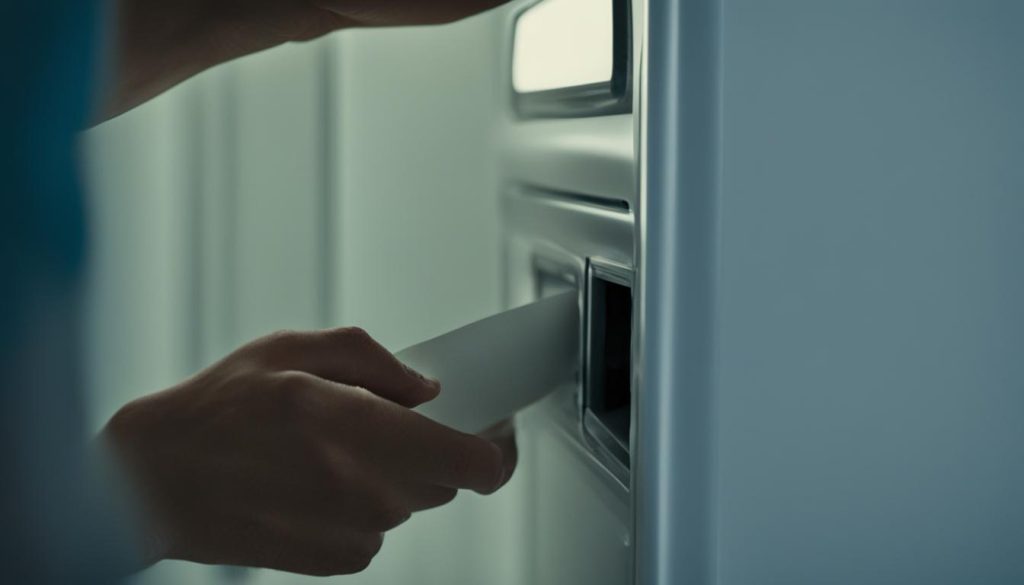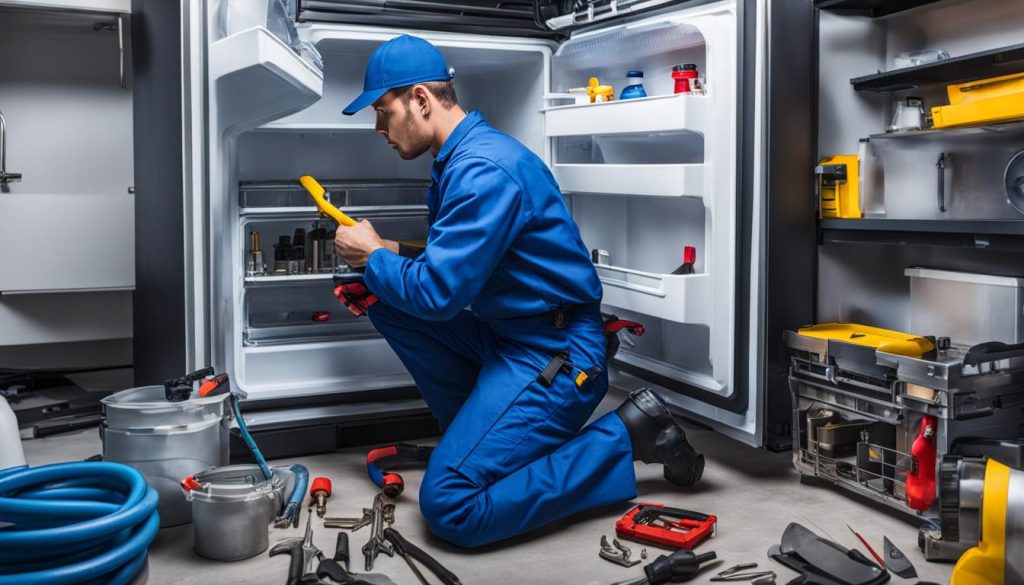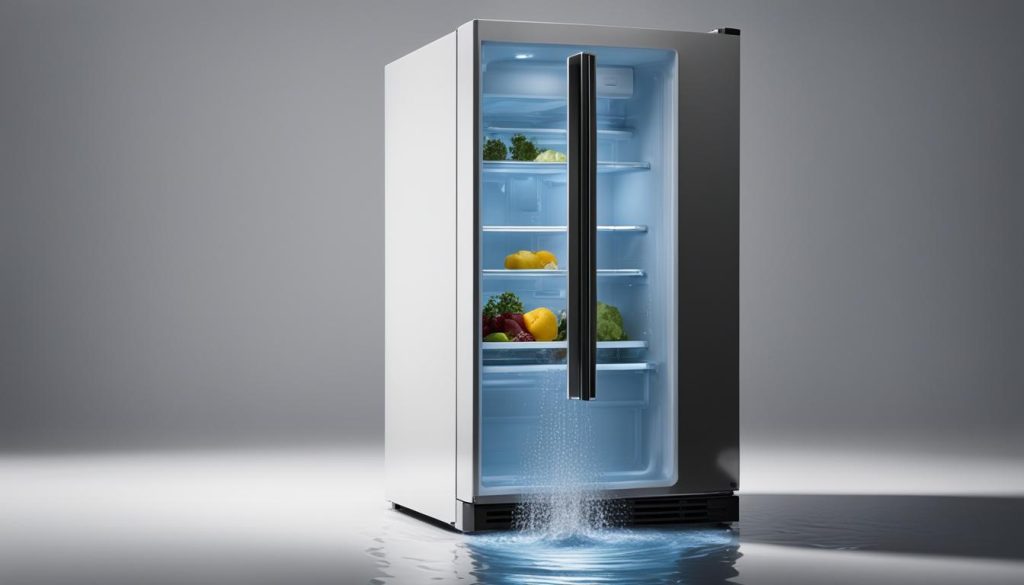If you’ve noticed water pooling around your refrigerator, it’s essential to act quickly to prevent damage to your appliance and surrounding areas. A leaking refrigerator can be caused by various factors, including faulty components, clogged drainage systems, and improper maintenance.
In this comprehensive guide, we will provide you with practical steps to help you identify and swiftly solve the issue of a leaking refrigerator in Canada. From checking the water supply line to inspecting the ice maker and water inlet valve, we’ll explore various strategies to help you troubleshoot and resolve the issue efficiently.
Key Takeaways:
- A leaking refrigerator can result from various causes, including faulty components, clogged drain lines, and improper maintenance.
- Quickly diagnosing and resolving a refrigerator leak can prevent further damage to your appliance and surrounding areas.
- By following the steps outlined in this guide, you should be able to identify and fix most refrigerator leaks, but professional assistance may be necessary in some cases.
- Regular maintenance can help prevent refrigerator leaks, so make sure to clean your appliance regularly and inspect it for any signs of damage.
- Remember to prioritize safety when working with your refrigerator, and if you’re unsure about any aspect of the repair process, consult a professional technician.
Common Causes of Refrigerator Leaks
A leaking fridge can be an inconvenience and a cause for concern. Understanding the common causes of refrigerator leaks can help you diagnose the issue and fix it quickly. Below are some of the common reasons why refrigerators leak:
- Blocked or clogged drain: When the defrost drain is clogged or blocked, the water that should flow down the drain and into the drip pan can back up and leak out of the refrigerator. This is one of the most common causes of refrigerator leaks and can often be fixed by cleaning the drain with hot water and a pipe cleaner.
- Broken water inlet valve: The water inlet valve controls the flow of water into the fridge. When the valve is broken or becomes loose, water can leak out of the refrigerator. You may need to replace the water inlet valve to fix the problem.
- Worn-out door gasket: A faulty door gasket can cause cold air to escape from the refrigerator, leading to excessive condensation and leaks. Check the door gasket for tears or gaps, and replace it if necessary.
- Improper levelling: If the refrigerator is not level, water can accumulate and leak out of the appliance. Use a level to ensure that the fridge is properly levelled, and adjust the levelling legs if necessary.
- Ice maker issues: If the ice maker is not functioning properly, it can cause water to leak out of the fridge. Check the ice maker for leaks, and replace any faulty components.
Note: If you notice water pooling at the base of the refrigerator, check the condenser coils for dust and debris. Dirty condenser coils can cause the fridge to overheat, leading to leaks. Use a vacuum cleaner or a coil brush to clean the coils.
By understanding the common causes of refrigerator leaks, you can take appropriate action to fix the issue and prevent it from happening again. In the next section, we will explore how to check the water supply line and diagnose any issues that may be causing the leak.
Checking the water supply line
A damaged or disconnected water supply line can be a potential cause of a leaking refrigerator. Before inspecting the other components, it is essential to check the water supply line.
- First, locate the water supply valve, typically found behind the refrigerator or under the sink.
- Ensure that the valve is fully open.
- Next, inspect the water supply line for any signs of damage, such as cracks, kinks, or leaks.
- If you notice any issues, turn off the water supply valve and replace the damaged line with a new one.
- If the water supply line appears to be in good condition, move on to checking the refrigerator water line.
To check the refrigerator water line:
- Locate the water inlet valve, typically found at the rear of the refrigerator.
- Inspect the tubing for any damage or clogs.
- If there are any problems, replace the tubing with a new one.
Tip: Before removing the water supply line, turn off the water supply valve to avoid any leaks or spills.
Inspecting the ice maker and water inlet valve
The ice maker and water inlet valve are essential components of your refrigerator that can contribute to leaks if they malfunction. Therefore, it is crucial to inspect them thoroughly in case they are causing the issue. Here are the steps to follow:
- Locate the ice maker and water inlet valve at the back of the fridge or in the bottom kickplate. You might need to remove the kickplate to access them.
- Inspect the water supply tube that connects the valve to the ice maker for any signs of damage. If it is damaged, replace it immediately.
- Check the water inlet valve for any cracks or leaks. If you notice any, replace the valve to avoid further damage.
- Turn off the water supply to the fridge and remove the inlet valve. Look for any debris or mineral buildup inside the valve and clean it out with warm water and a soft-bristled brush.
- Once you have cleaned the valve, reattach it to the fridge and turn the water supply back on.
- Run a test cycle on the ice maker to ensure it is functioning correctly.
If you find any issues during this inspection, it may be necessary to replace the ice maker or water inlet valve. Note that these components can vary in design, so refer to your refrigerator’s user manual for specific instructions on how to replace them.
By inspecting the ice maker and water inlet valve, you can identify if they are contributing to the leak and take the necessary steps to fix the problem.
Cleaning the Defrost Drain
A clogged defrost drain is a common cause of refrigerator leaks. The drain is responsible for removing water that has melted from the evaporator coils during the defrost cycle. If the drain becomes clogged, the water will accumulate and leak out of the refrigerator.
To clean the defrost drain, follow these steps:
- Unplug the refrigerator from the power outlet.
- Locate the defrost drain at the back of the freezer compartment. It may be covered by a panel.
- Remove any debris or ice buildup from the drain opening using a plastic utensil or turkey baster. Do not use metal objects, as they may damage the drain or coils.
- Pour hot water down the drain to flush out any remaining debris.
- Replace the drain cover or panel and plug the refrigerator back in.
If the drain continues to be clogged, you may need to repeat the process or use a defrost drain cleaner. These products are available at most hardware and home improvement stores. Follow the manufacturer’s instructions carefully.
Regular maintenance can help prevent a clogged defrost drain. Be sure to clean the drain every 6 months or as needed, depending on your usage and environment.
Clearing the Condensation Drain Line
If you’ve ruled out issues with the water supply line or the ice maker, a clogged condensation drain line may be the culprit behind your leaking refrigerator in Canada. The condensation drain is responsible for removing excess moisture that accumulates during the refrigeration process. If this drain becomes clogged, water can back up and leak out of the fridge.
To clear the condensation drain line:
- Unplug the refrigerator and locate the condensation drain line at the back of the unit. It’s usually found near the compressor or the evaporator.
- Gently remove any visible debris from the entrance of the drain line using a small brush or a pipe cleaner.
- Next, use a turkey baster or a syringe to flush warm water down the drain line, being careful not to use too much pressure or force. Keep flushing until the water runs freely through the drain line and out of the bottom of the fridge.
- Finally, wipe down the area with a clean cloth and plug the fridge back in.
It’s important to note that some refrigerators may have a built-in drain pan that collects excess water. If your fridge has this feature, make sure to empty the drain pan regularly to prevent overflow and potential leaks.
Tip: A mixture of equal parts water and white vinegar can be used to flush the condensation drain line and remove any built-up residue or bacteria.
Checking the door gaskets
One of the causes of a leaking refrigerator is faulty door gaskets. The door gaskets are responsible for creating a seal between the refrigerator and freezer doors and the cabinet. If they are worn out, torn, or dirty, they can allow warm, moist air to enter the refrigerator, leading to condensation, which can cause leaks. Checking the door gaskets is an easy task that can help diagnose the leaking problem.
To inspect the door gaskets, close the refrigerator door on a piece of paper and try to pull it out. If the paper comes out easily, it’s a sign that the door gaskets are defective and need to be replaced. You can also visually inspect the gaskets for any signs of cracks, tears, or deformities. Clean the gaskets with warm, soapy water and a soft cloth to remove any dirt or debris that may prevent them from creating a tight seal.

Replacing the door gaskets is a job best left to a professional. Contact a trusted fridge repair service in Canada to have the gaskets replaced. Properly functioning door gaskets will help keep moisture and warm air out of your refrigerator, preventing leaks and saving energy.
Proper Leveling of the Refrigerator
Ensuring your refrigerator is levelled correctly is an essential factor in preventing leaks. An unsteady refrigerator can lead to water pooling and eventually leaking out of the unit. To level your refrigerator:
- Use a levelling tool to determine which side of the refrigerator needs adjusting.
- Locate the levelling legs at the bottom of the refrigerator on the side that requires adjustment.
- Using a wrench, turn the levelling leg in the direction necessary to level the refrigerator.
- Check for levelness using the levelling tool once again. If necessary, repeat the process until the refrigerator stands even on all sides.
It is important to note that the level of your refrigerator can also affect its cooling performance. An unlevelled refrigerator can cause the doors to close improperly, causing air leaks and temperature imbalances. This can lead to spoiled food and energy inefficiency, resulting in higher electricity costs.
By ensuring your refrigerator is levelled, you can improve its stability, reduce the risk of leaks, and promote its optimal performance. For more information on maintaining your refrigerator, be sure to read our other sections in this comprehensive guide.
Addressing ice buildup in the freezer
If you notice ice buildup in the freezer, it could be causing your refrigerator to leak. The excess ice can obstruct the freezer’s drainage system and cause water to overflow and leak from the fridge.
The first step in addressing the issue is to defrost the freezer. Remove all food items from the freezer and unplug the refrigerator. Place towels around the base of the unit to catch any dripping water. Once the ice has melted, clean the freezer and dry it thoroughly.
If the problem persists, you may need to check for other causes. Make sure the freezer door is closing properly and that the door gasket is in good condition. If there is damage to the gasket, it should be replaced immediately to prevent further leakage.
Preventing Ice Buildup
Preventing ice buildup in the freezer is key to avoiding future leaks. Here are some tips:
- Make sure the freezer door is always closed tightly.
- Do not overstuff the freezer with food, as this can obstruct the airflow.
- Regularly defrost the freezer to prevent ice buildup.
- Check the freezer temperature. It should be set to 0 degrees Fahrenheit (-18 degrees Celsius) or lower.
By following these steps, you should be able to address the issue of ice buildup in the freezer and prevent future leaks.
Seeking Professional Assistance For Refrigerator Repair in Canada
If the steps outlined in this guide do not resolve your leaking refrigerator issue, it may be time to seek professional assistance. Attempting to fix complex refrigerator problems on your own can be dangerous and may result in further damage to your appliance. A qualified professional can diagnose the problem and provide safe, effective solutions.
Choosing a Refrigerator Repair Service
When looking for a refrigerator repair service in Canada, consider the following:
| Factor | Consideration |
|---|---|
| Experience | Choose a company with years of experience in repairing refrigerators to ensure they have the necessary expertise to solve your problem. |
| Reputation | Read customer reviews or ask for referrals from friends and family to find a trustworthy, reliable repair service. |
| Cost | Get quotes from multiple repair services to compare prices and ensure that the cost is fair and reasonable for the type of repair needed. |
| Licensing and Insurance | Choose a repair service that is licensed and insured to protect yourself against any potential liability or damage to your property. |
When you have chosen a repair service, make sure to ask about their guarantee or warranty on their work. A good repair service will stand behind their work and offer a guarantee or warranty on their services.
Calling a Refrigerator Repair Technician
When you call a refrigerator repair technician, be sure to describe the problem in detail. The technician may ask you questions to help diagnose the problem and determine the best course of action. They may also ask you for the make and model of your refrigerator, so be sure to have this information on hand.
When the technician arrives, make sure to show them the leaking refrigerator and explain any steps you have taken to address the problem. The technician will then diagnose the issue and provide you with a detailed quote for the repair. If you agree to the repair, they will proceed with the work, using their specialized tools and expertise to fix the problem.

Remember, attempting to fix complex refrigerator problems on your own can be dangerous and may cause further damage to your appliance. If you are unsure about any aspect of refrigerator repair, it is always best to seek professional assistance.
Conclusion
Fixing a leaking refrigerator may seem like a daunting task, but with the right guidance and tools, it can be a manageable DIY project. By identifying the common causes of refrigerator leaks, such as faulty components, improper maintenance, and clogged drain lines, you can take proactive steps to prevent further damage to your appliance.
Remember to prioritize safety
Always prioritize safety when working with appliances that involve electrical components and water. Make sure to unplug your refrigerator before attempting any repairs or inspections, and wear appropriate protective gear, such as gloves and safety goggles.
When to seek professional assistance
If you have followed the steps outlined in this guide and still have a leaking refrigerator, it may be time to call in a professional for assistance. Look for reliable repair services in your area and consult with a certified technician to diagnose and fix the problem.
Remember, addressing a refrigerator leak promptly can prevent further damage and ensure the continued efficient operation of your appliance.

Written by Max | An appliance repair technician with more than 15 years experience in appliance repair services in Toronto and the GTA.
Disclaimer: This post "How do I fix a leaking refrigerator?" is for information purposes only. If you need specific help, please contact Max Appliance Repair at https://www.maxappliancerepair.ca/contact/.